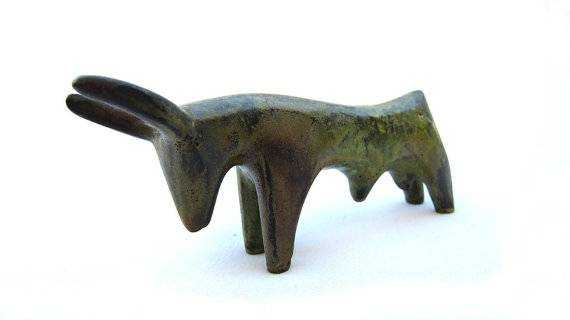Paganistan: Notes from the Secret Commonwealth
In Which One Midwest Man-in-Black Confers, Converses & Otherwise Hob-Nobs with his Fellow Hob-Men (& -Women) Concerning the Sundry Ways of the Famed but Ill-Starred Tribe of Witches.
Bull Stone Rising: Some Thoughts on Foundation Offerings
When you raise a standing stone, or build an important structure like a house or a temple, you'd do well to begin by making a foundation offering first. That's the pagan way.
What archaeologists call the “foundation deposit” is prayer made permanent. It embodies, in an ongoing way, the builder's intentions for the new structure, constituting the foundation beneath the foundation.
Among the Copper Age cultures of what archaeologist Marija Gimbutas called Old Europe—as in Minoan Crete, Old Europe's final flourishing—it was not uncommon, when building a house, to bury beneath it first a small, clay model of a house: action made articulate. The intention could hardly be clearer.
So when, at Beltane, we raise the Bull Stone at Sweetwood Sanctuary in southwestern Witchconsin's Driftless Area, you can be sure that, before the raising of the Stone itself, we'll first be laying our intentions in Earth.
The Bull Stone marks the marriage point of Earth with Sun, of People with Land. The Stone itself makes the Great Marriage with the Land both in microcosm—at the shrine itself—and in macrocosm, lining up with the notch on the horizon where two ridges meet that marks the place where the Sun sets on the shortest day of the year.
In the Earth beneath the Bull Stone we will lay three carefully-chosen offerings:
A little bronze bull with gilded horns.
From this, the Bull Stone takes it name. It embodies our ongoing prayers for the Herds. Note that the ancestors customarily gilded the horns of sacrificial animals.
A chert spear-point.
Indigenous peoples of the Driftless knapped their tools from locally-sourced chert; you can still find unworked nodules of the stone in the coulee (ravine) downslope from our new shrine, whence, incidentally, the Bull Stone itself took origin. This embodies our ongoing prayers for the Hunt.
An ear of corn.
Here in Corn Country, this offering embodies our prayers for the Crops. This—the Mother Grain of the Americas—is the Mystery offering, the invisible offering that archaeologists will never find because, in its making, it will become one with the Earth in which it lies.
These, then, will be the permanent prayers that the Bull Stone Shrine silently voices, and which every act of love and worship made there will reinforce.
To which, let us all say: So mote it be.
The Bull Stone will be raised at Beltane 2020, and enhallowed at three subsequent Consecration Feasts through the following summer.
For more information, watch this blog or the Sweetwood website.
Comments
-
Please login first in order for you to submit comments

















I know that many people would include fishing as part of the hunt, as in "hunting and fishing" however I tend to view fishing as a separate activity. If there are any fishermen among your group please confer with them. I bow to their superior knowledge of your local waterways if they feel the spear point suffices that's fine, but if not please consider including a fishhook as well.